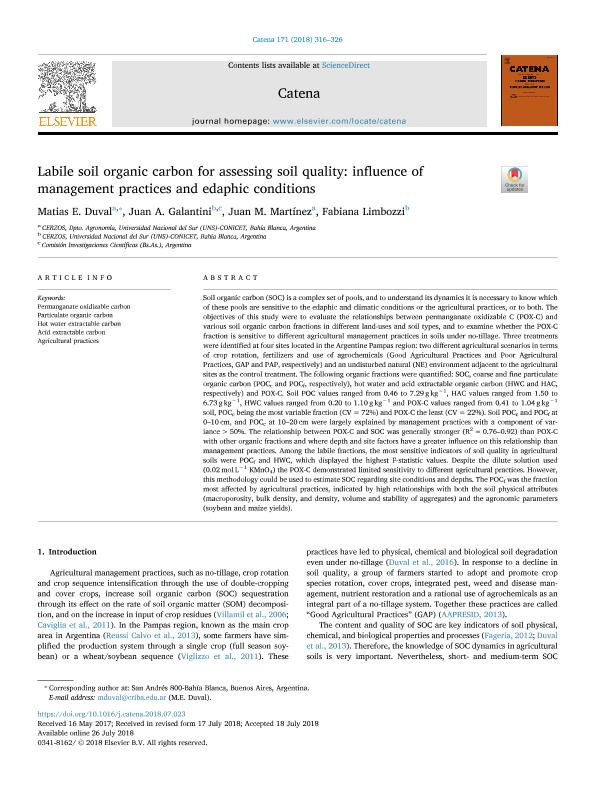Mostrar el registro sencillo del ítem
dc.contributor.author
Duval, Matias Ezequiel

dc.contributor.author
Galantini, Juan Alberto

dc.contributor.author
Martinez, Juan Manuel

dc.contributor.author
Limbozzi, Fabiana

dc.date.available
2019-10-28T14:29:26Z
dc.date.issued
2018-12
dc.identifier.citation
Duval, Matias Ezequiel; Galantini, Juan Alberto; Martinez, Juan Manuel; Limbozzi, Fabiana; Labile soil organic carbon for assessing soil quality: influence of management practices and edaphic conditions; Elsevier Science; Catena; 171; 12-2018; 316-326
dc.identifier.issn
0341-8162
dc.identifier.uri
http://hdl.handle.net/11336/87382
dc.description.abstract
Soil organic carbon (SOC) is a complex set of pools, and to understand its dynamics it is necessary to know which of these pools are sensitive to the edaphic and climatic conditions or the agricultural practices, or to both. The objectives of this study were to evaluate the relationships between permanganate oxidizable C (POX-C) and various soil organic carbon fractions in different land-uses and soil types, and to examine whether the POX-C fraction is sensitive to different agricultural management practices in soils under no-tillage. Three treatments were identified at four sites located in the Argentine Pampas region: two different agricultural scenarios in terms of crop rotation, fertilizers and use of agrochemicals (Good Agricultural Practices and Poor Agricultural Practices, GAP and PAP, respectively) and an undisturbed natural (NE) environment adjacent to the agricultural sites as the control treatment. The following organic fractions were quantified: SOC, coarse and fine particulate organic carbon (POCc and POCf, respectively), hot water and acid extractable organic carbon (HWC and HAC, respectively) and POX-C. Soil POC values ranged from 0.46 to 7.29 g kg−1, HAC values ranged from 1.50 to 6.73 g kg−1, HWC values ranged from 0.20 to 1.10 g kg−1 and POX-C values ranged from 0.41 to 1.04 g kg−1 soil, POCc being the most variable fraction (CV = 72%) and POX-C the least (CV = 22%). Soil POCc and POCf at 0–10 cm, and POCc at 10–20 cm were largely explained by management practices with a component of variance >50%. The relationship between POX-C and SOC was generally stronger (R2 = 0.76–0.92) than POX-C with other organic fractions and where depth and site factors have a greater influence on this relationship than management practices. Among the labile fractions, the most sensitive indicators of soil quality in agricultural soils were POCf and HWC, which displayed the highest F-statistic values. Despite the dilute solution used (0.02 mol L−1 KMnO4) the POX-C demonstrated limited sensitivity to different agricultural practices. However, this methodology could be used to estimate SOC regarding site conditions and depths. The POCf was the fraction most affected by agricultural practices, indicated by high relationships with both the soil physical attributes (macroporosity, bulk density, and density, volume and stability of aggregates) and the agronomic parameters (soybean and maize yields).
dc.format
application/pdf
dc.language.iso
eng
dc.publisher
Elsevier Science

dc.rights
info:eu-repo/semantics/openAccess
dc.rights.uri
https://creativecommons.org/licenses/by-nc-sa/2.5/ar/
dc.subject
ACID EXTRACTABLE CARBON
dc.subject
AGRICULTURAL PRACTICES
dc.subject
HOT WATER EXTRACTABLE CARBON
dc.subject
PARTICULATE ORGANIC CARBON
dc.subject
PERMANGANATE OXIDIZABLE CARBON
dc.subject.classification
Ciencias del Suelo

dc.subject.classification
Agricultura, Silvicultura y Pesca

dc.subject.classification
CIENCIAS AGRÍCOLAS

dc.title
Labile soil organic carbon for assessing soil quality: influence of management practices and edaphic conditions
dc.type
info:eu-repo/semantics/article
dc.type
info:ar-repo/semantics/artículo
dc.type
info:eu-repo/semantics/publishedVersion
dc.date.updated
2019-10-22T17:40:21Z
dc.journal.volume
171
dc.journal.pagination
316-326
dc.journal.pais
Países Bajos

dc.journal.ciudad
Amsterdam
dc.description.fil
Fil: Duval, Matias Ezequiel. Consejo Nacional de Investigaciones Científicas y Técnicas. Centro Científico Tecnológico Conicet - Bahía Blanca. Centro de Recursos Naturales Renovables de la Zona Semiárida. Universidad Nacional del Sur. Centro de Recursos Naturales Renovables de la Zona Semiárida; Argentina. Universidad Nacional del Sur. Departamento de Agronomía; Argentina
dc.description.fil
Fil: Galantini, Juan Alberto. Provincia de Buenos Aires. Gobernación. Comisión de Investigaciones Científicas; Argentina. Consejo Nacional de Investigaciones Científicas y Técnicas. Centro Científico Tecnológico Conicet - Bahía Blanca. Centro de Recursos Naturales Renovables de la Zona Semiárida. Universidad Nacional del Sur. Centro de Recursos Naturales Renovables de la Zona Semiárida; Argentina
dc.description.fil
Fil: Martinez, Juan Manuel. Universidad Nacional del Sur. Departamento de Agronomía; Argentina. Consejo Nacional de Investigaciones Científicas y Técnicas. Centro Científico Tecnológico Conicet - Bahía Blanca. Centro de Recursos Naturales Renovables de la Zona Semiárida. Universidad Nacional del Sur. Centro de Recursos Naturales Renovables de la Zona Semiárida; Argentina
dc.description.fil
Fil: Limbozzi, Fabiana. Consejo Nacional de Investigaciones Científicas y Técnicas. Centro Científico Tecnológico Conicet - Bahía Blanca. Centro de Recursos Naturales Renovables de la Zona Semiárida. Universidad Nacional del Sur. Centro de Recursos Naturales Renovables de la Zona Semiárida; Argentina
dc.journal.title
Catena

dc.relation.alternativeid
info:eu-repo/semantics/altIdentifier/url/https://www.sciencedirect.com/science/article/pii/S034181621830300X
dc.relation.alternativeid
info:eu-repo/semantics/altIdentifier/doi/http://dx.doi.org/10.1016/j.catena.2018.07.023
Archivos asociados
